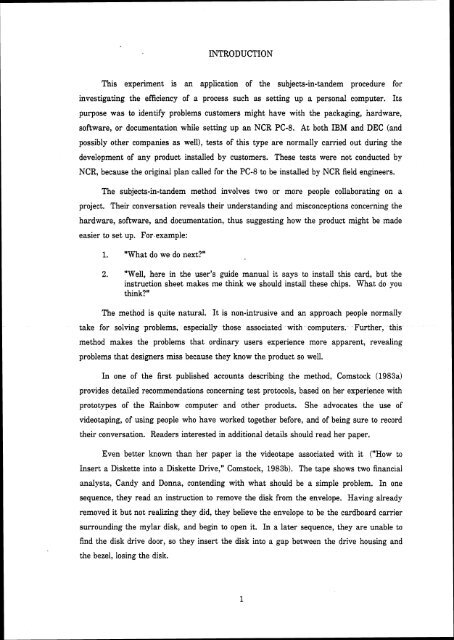Customer Setup of the NCR PC-8. - THE CORE MEMORY
Customer Setup of the NCR PC-8. - THE CORE MEMORY
Customer Setup of the NCR PC-8. - THE CORE MEMORY
- No tags were found...
You also want an ePaper? Increase the reach of your titles
YUMPU automatically turns print PDFs into web optimized ePapers that Google loves.
INTRODUCTIONThis experiment is an application <strong>of</strong> <strong>the</strong> subjects-in-tandem procedure forinvestigating <strong>the</strong> efficiency <strong>of</strong> a process such as setting up a personal computer. Itspurpose was to identify problems customers might have with <strong>the</strong> packaging, hardware,s<strong>of</strong>tvare, or documentation while setting up an <strong>NCR</strong> <strong>PC</strong>-<strong>8.</strong> At both IBM and DEC (andpossibly o<strong>the</strong>r companies as well), tests <strong>of</strong> this type are normally carried out during <strong>the</strong>development <strong>of</strong> any product installed by customers. These tests were not conducted by<strong>NCR</strong>, because <strong>the</strong> original plan called for <strong>the</strong> <strong>PC</strong>-$ to be installed by <strong>NCR</strong> field engineers.The subjects-in-tandem method involves two or more people collaborating on aproject. Their conversation reveals <strong>the</strong>ir understanding and misconceptions concerning <strong>the</strong>hard~are, s<strong>of</strong>tware, and documentation, thus suggesting how <strong>the</strong> product might be madeeasier to set up. For.example:1. "What do we do next?"2. "Well, here in <strong>the</strong> user's guide manual it says to install this card, but <strong>the</strong>instruction sheet makes me think we should install <strong>the</strong>se chips. What do youthink?"The method is quite natural. It is non-intrusive and an approach people normallytake for solving problems, especially those associated with computers. Fur<strong>the</strong>r, thismethod makes <strong>the</strong> problems that ordinary users experience more apparent, revealingproblems that designers miss because <strong>the</strong>y know <strong>the</strong> product so well.In one <strong>of</strong> <strong>the</strong> first published accounts describing <strong>the</strong> method, Comstock (1983a)provides detailed recommendations concerning test protocols, based on her experience withprototypes <strong>of</strong> <strong>the</strong> Rainbow computer and o<strong>the</strong>r products. She advocates <strong>the</strong> use <strong>of</strong>videotaping, <strong>of</strong> using people who have worked toge<strong>the</strong>r before, and <strong>of</strong> being sure to record<strong>the</strong>ir conversation. Readers interested in additional details should read her paper.Even better known than her paper is <strong>the</strong> videotape associated with it ("How toInsert a Diskette into a Diskette Drive," Comstock, 1983b). The tape shows two financialanalysts, Candy and Donna, contending with what should be a simple problem. In onesequence, <strong>the</strong>y read aln instruction to remove <strong>the</strong> disk from <strong>the</strong> envelope. Having alreadyremoved it but not realizing <strong>the</strong>y did, <strong>the</strong>y believe <strong>the</strong> envelope to be <strong>the</strong> cardboard carriersurrounding <strong>the</strong> mylar disk, and begin to open it. In a later sequence, <strong>the</strong>y are unable t<strong>of</strong>ind <strong>the</strong> disk drive door, so <strong>the</strong>y insert <strong>the</strong> disk into a gap between <strong>the</strong> drive housing and<strong>the</strong> bezel, losing <strong>the</strong> disk.
















